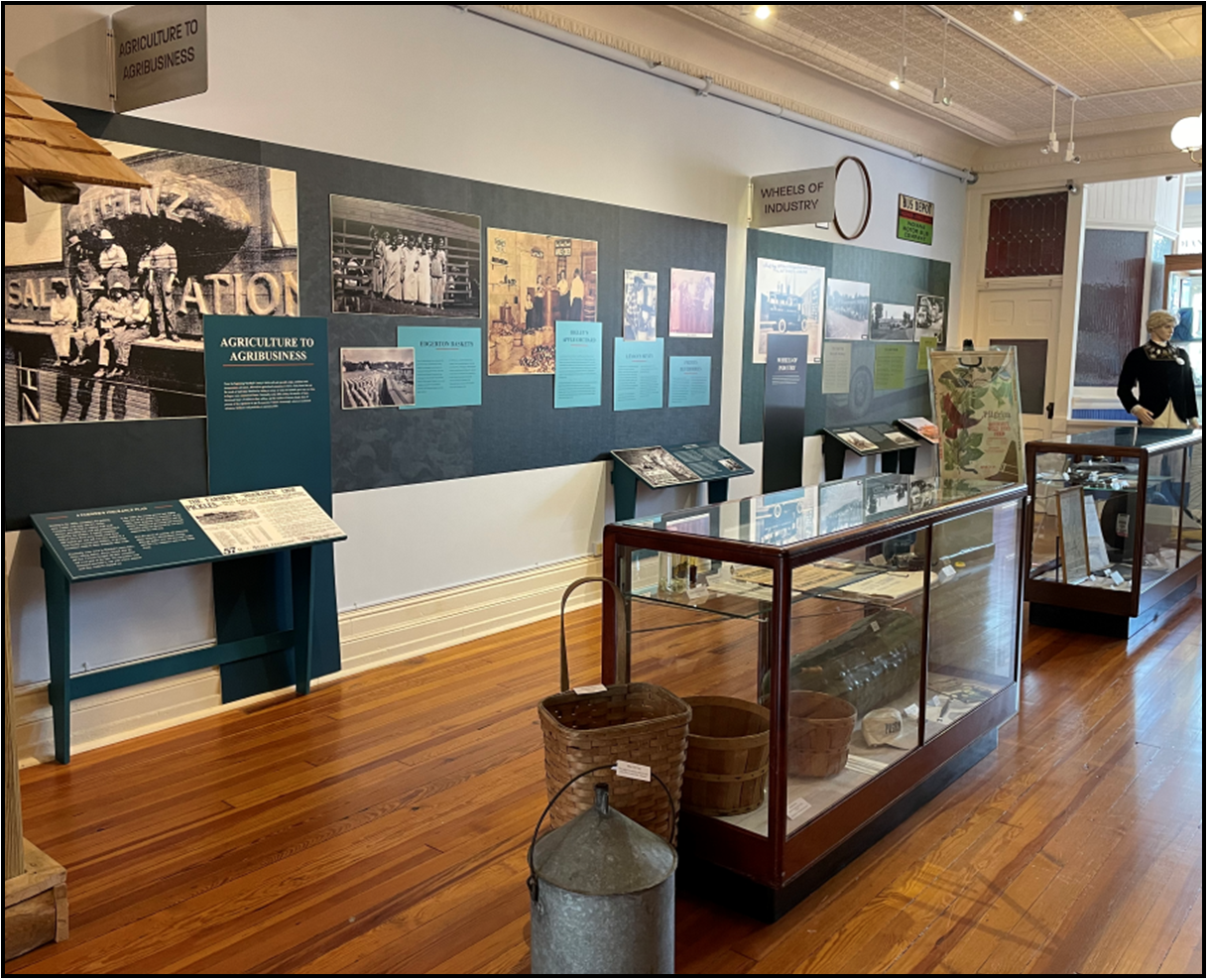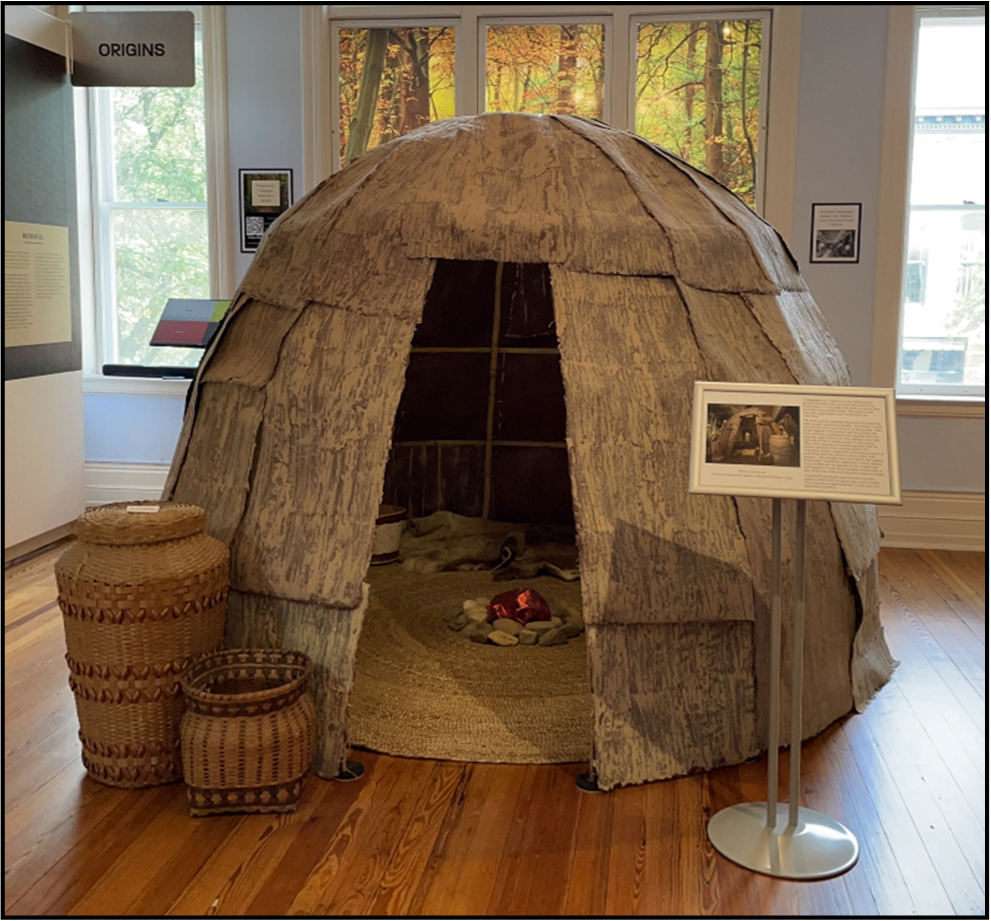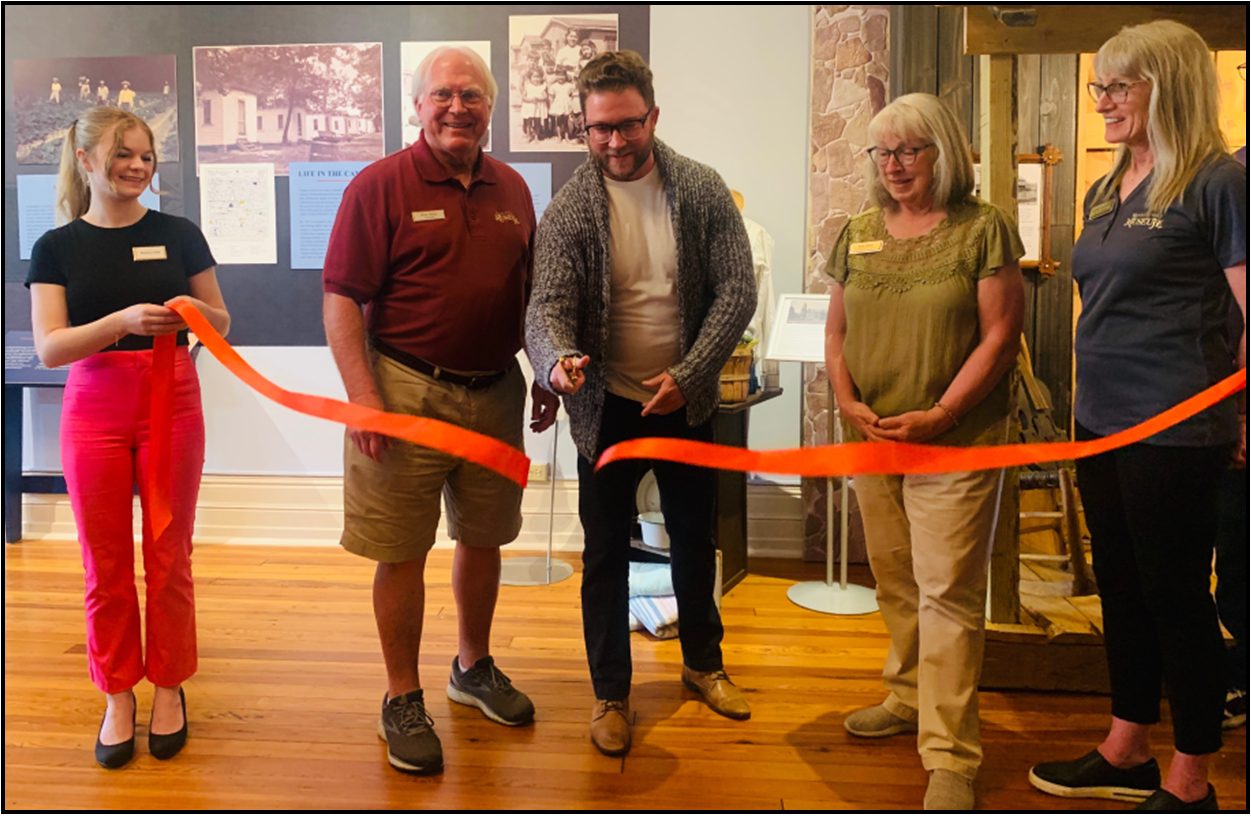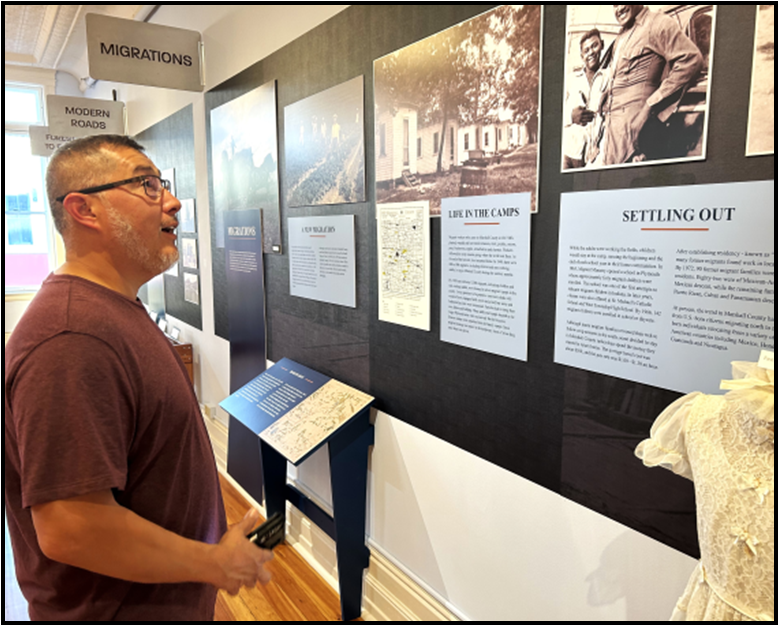In this interview with Marshall County Historical Society, we learn about how the museum’s new Historic Crossroads Center has transformed visitor experience and expanded the museum’s outreach efforts, as well as unpack their lessons-learned and hopes for the future.
Could you share a little bit about your organization, its size, and the audiences you serve?
In existence since the 1800s, the Marshall County Historical Society is a non-profit, 501c3 organization. We partnered with local county government beginning in 1957 and serve a rural community in northern Indiana. In 1958 the Marshall County Museum opened to the public on a limited basis in Plymouth, the county seat. In 1971, we moved to larger quarters in the carriage house of a historic home, and in 1993 community support and grant funds allowed the Society to purchase the Lauer Building, a former department store. Ten years later MCHS bought the two buildings adjacent to the existing Museum, once again through fundraising and grant sourcing, increasing available space 100 percent, making possible a community room and an award-winning research library. The expansion and renovation were completed in 2010. All told, MCHS occupies 30,000 square feet of downtown space. Our volunteer network was key at every step; last year, they logged more than 5,000 hours on the MCHS’ behalf.
In 2023 MCHS welcomed almost 7,000 visitors, fulfilled 400 research requests and accessioned 1,500+ artifacts. While the majority of our visitors are from the area, we also host visitors from all over the United States and as far away as China. Our social media presence has increased significantly since 2020, and we just launched our new website, which will allow us another way to fulfill our mission to offer Marshall County’s stories and to a wider, more diverse audience.
Your museum recently reimagined a permanent exhibit to create what is called the Historic Crossroads Center (HCC). What prompted you to take on this project?
Almost two decades ago MCHS undertook a project to explain the unique position our county holds in early road building. As the only place where five of the earliest historic highways intersect, the story was, and is, central to county development, connecting past to present and touching on many areas of life here, all related to the theme of transportation.
Over the years, time and changing circumstances made the original exhibit less impactful. We needed to tell the story more cohesively and with greater depth and inclusivity. For example, at the time, the Museum’s treatment of Native American history was housed in a small separate room and consisted mostly of arrowheads and other artifacts without any emphasis on the story of the people told from their point of view. Another area of transportation history, Latin migration, was totally missing. More than 25 percent of our local population currently consists of people of Latin origin. It was time to work with these communities to tell a portion of their story as well.
In addition to the gaps in our history, some physical elements of the original exhibit did not age well. For instance, pushbutton storytelling panels did not lend themselves to a guided tour format. Freestanding T-walls designed to expand exhibit space instead led to blind corners and poor sight lines. The floor plan led to “islands” of information rather than suggesting a logical path around the room.
What are some of the themes addressed in the HCC?
We reorganized the entire space as a transportation chronology, creating seven multi-sensory story stations. Beginning with the Potawatomi origin story — complete with a three-quarter sized wigwam, a scent station and an interactive language module — the exhibit explains the impact modern road building had on our Indigenous population and natural landscape. It goes on to detail the western migration of European and early American groups, and the northern migration of various Latin heritage groups.
We extended our theme to include agriculture, agribusiness, transportation-related industry and tourism. Other special features include a road surface table that allows visitors to see and feel the various road building materials, a life-sized settler’s cabin façade, a big-wheel bicycle to illustrate the county’s bicycle boom in the late 1800s and many large-scale photographs. Reading rails in strategic places allowed us to tell the story in greater detail without crowding the space.
One element of the previous exhibit that worked well as a teaching tool is an 18-foot free-standing module that includes an interactive map with the five original historic highways highlighted. We were able to blend that seamlessly into the new design. In addition, the new layout removed the T-walls, using much of the resultant floor space for low glass cases that enrich the story by displaying relevant artifacts.
What resources (time, talent and funding) were needed to make this possible? How was the project funded?
Planning for the project began in summer 2022. Next, we wrote the grant to secure funding, and then began the research and design phase. As part of our research early on, we sought to make connections with Marshall County’s Latin community and the descendants of the former Potawatomi community, so they could tell their own stories. The dismantling of the old exhibit and construction of the new extended from summer 2022 to spring 2023.
We engaged the services of Nora Pinell-Hernandez, founding creative director of Atomic Carrots, Oakland Park, FL, an exhibit design firm, who helped us with the design elements and fabricated a three-quarter-sized wigwam. Then Beth Schoberg, Graphics Unlimited, Bremen, IN, and her team brought Nora’s ideas to life, printing wall graphics and large photographs. Multiple staff members and volunteers lent time and talent to clearing and readying the space. Blake Norton, director of the Citizen Potawatomi Nation Cultural Heritage Center, Shawnee, OK, and a focus group of local Latin heritage residents helped us tell a portion of their respective Marshall County histories. Jeannette Rooney and Tamara Hemmerlein from the Indiana Historical Society provided invaluable feedback and technical assistance, as did our Marshall County Historian Kurt Garner.
Most of the funding for the project came from a Heritage Support Grant, provided by the Indiana Historical Society and made possible by the Lilly Endowment, Inc., along with a required 15 percent match. Additional funding included support from Marshall County REMC and the Marshall County Crossroads Arts & Culture Subcommittee. Our overall annual exhibits budget is very modest, so a large-scale project like this requires grant funding.
Have you engaged members of your communities in the process? What role did they play and how did you work together?
One of the outcomes of the HCC project has been a close working relationship with the Citizen Potawatomi Nation Cultural Heritage Center. Their director, Blake Norton, generously collaborated with us – writing text, suggesting artwork, consulting on our model wigwam and serving as our grand opening keynote speaker. In turn, while here, Blake discovered some key original documents in our library that we were able to share for their archives. In addition, we formed a focus group of local people who had been migrant workers or were descended from migrant families. These community members helped us tell the migrant story with sensitivity and relevance.
It sounds like this project has led to some long-lasting relationships, which I’m sure has some ripples into other work that your museum is doing. In what ways have these new relationships activated new programs or other opportunities?
We continue to enjoy relationships with these groups and others to refine and deepen the story. As a direct result of outreach to our Latin community, for the first time we participated in the annual Latino Fest, gained a board member of Latin descent, hosted a traveling exhibit — Be Heard: Latino Experiences in Indiana — and held two special events in conjunction with La Voz Unida, a local Latin support community. We have also worked with them to develop window displays that highlight important Latin origin events and to translate written materials into Spanish, which we intend to do on an ongoing basis. The visitor feedback has been very positive.
We have been surprised and gratified by the number of personal stories that have sprung from the story section on the Latin migration. We did a lot of research into the local story of migrant farm workers, both with farm families who employed migrants and maintained migrant camps, and with residents whose families first came to the county as migrant workers and decided to stay. A number of people have shared their own stories with us in the course of a tour. For example, one gentleman from outside the county talked about his experience as a teenager working with migrant children as part of the migrant ministry referenced in the exhibit. Another visitor told stories about growing up with the children of migrant workers his father employed. A relatively new resident of Marshall County became a Historical Society member and had some excellent suggestions for how we can be more inclusive of our Spanish speaking visitors.
Another outcome of the new exhibit has been increased involvement of our elementary schools. We partner with a local service group to present a program for fourth graders that supports state educational standards. The students work in groups to ‘pack’ a miniature covered wagon. Then they tour the HCC along with some other areas of the Museum, actually seeing some of the artifacts they just discussed, such as an oxen yoke, spinning wheel, butter churn and washboard. One of our elementary schools carries the name of a Potawatomi chief, Menominee, who figures prominently in the story told in the HCC. Experiencing this exhibit, many children suddenly understand the context.
Anything that you wish you could have or would have done differently?
It would have helped the process greatly to have had more experience with exhibit design and creation going into the project. Being fairly new to working on such a large-scale exhibit, it took a while for the in-house team and our chosen professional partners to fully connect with and understand one another. We learned a great deal and will have a much quicker start the next time.
As you look into the future, what are your hopes for the HCC?
The Historic Crossroads Center aligns closely with our mission and core values. We believe the power of story creates and promotes county pride and well-being. We hope all visitors find something that resonates with their story and that they also come away with a greater appreciation of our county history. In addition, improving our diversity is key as we move into the future, as does increasing our connection with local schools.
If you could offer one piece of advice to museums considering similar projects, what would it be?
Don’t underestimate the amount of time needed – break the project into small, manageable chunks; evaluate and make the best of everyone’s strengths; start with a logic model; create a flexible timeline. Then, when it comes to opening day, try to relax and enjoy!




